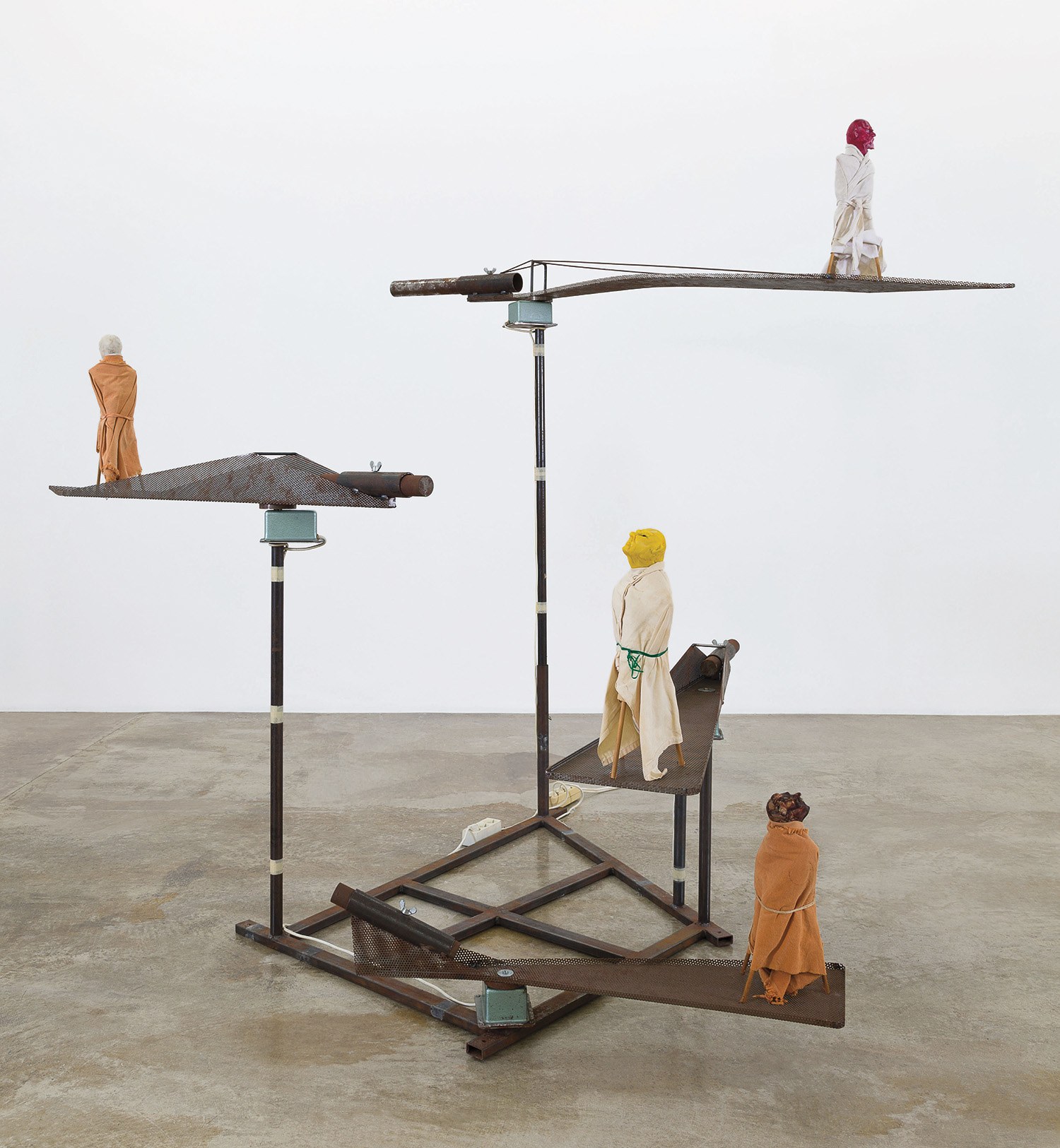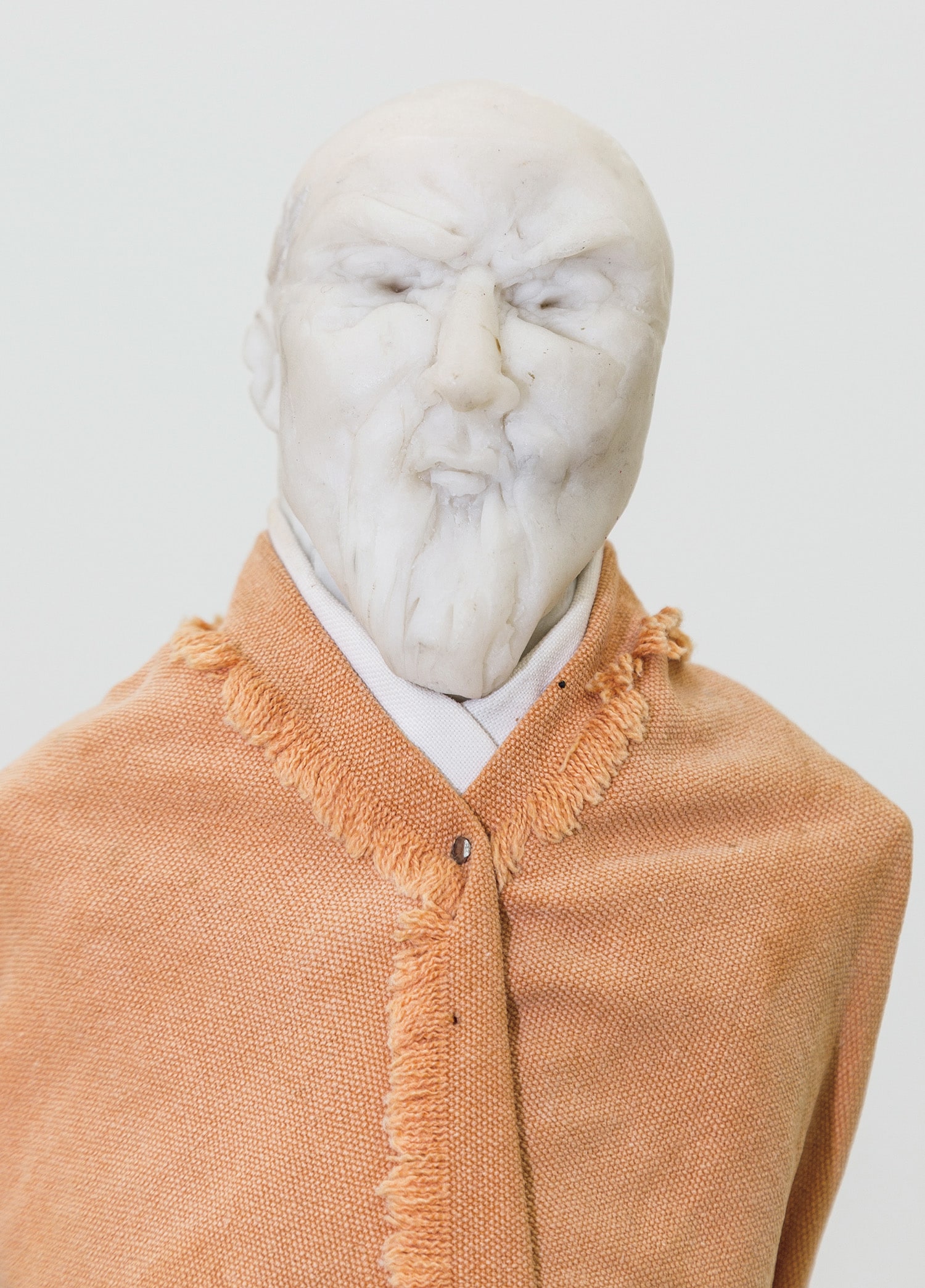









28
Thomas Schütte
Maschine
4 wax figures, wood, fabric, metal armature, electric motor and rubber gasket
each figure 41.3 x 15.2 x 17.8 cm (16 1/4 x 5 7/8 x 7 in.)
overall 180.9 x 340.4 x 309.9 cm (71 1/4 x 134 x 122 in.)
overall 180.9 x 340.4 x 309.9 cm (71 1/4 x 134 x 122 in.)
Executed in 1993.
Full-Cataloguing
A foremost re-inventor of modern sculpture, Thomas Schütte has forged a singular artistic lexicon that shuns institutionalised modes of classification. Movable and adjustable, Maschine, 1993, is a particularly resourceful example of the German artist’s cross-genre practice. Coalescing buoyant kinetic energy and astounding sculptural detail, the work oscillates between the majestic and the bizarre, the theatrical and the ominous. Its four outlandish figures, swathed in multi-coloured robes bound at the waist, seem like they are subjected to their mechanised structure’s authority, in a gravitational pull that is redolent of Alexander Calder’s elegant stabiles. The viewer is forced to reckon with the work’s ambivalent dynamic, opposing the machine and the creatures’ anthropomorphic silhouettes, which are placed at differing levels atop rotating steel armatures. ‘The things you cannot talk about - these are essential’, Schütte has said. ‘I believe that material, form and color have their own language that cannot be translated. Direct experience is much more touching than media, photographs and so on’ (Thomas Schütte, Thomas Schütte, London, 1998, p. 22). Transcending the act of representation, Maschine posits as pure embodiment; it combines a number of the artist’s most daring idiosyncracies in art, which were most recently celebrated at La Monnaie de Paris in 2019.
Studying at the Kunstakademie Düsseldorf from 1973 to 1981, Schütte encountered such eminent figures as Gerhard Richter, Fritz Schwegler, Daniel Buren and Benjamin Buchloh whilst developing his early oeuvre, all of whom bore an important impression on his work. His propensity to push formal and thematic boundaries can certainly be understood as a consequence of his education under the ‘merciless’ tutelage of his teacher, Gerhard Richter. Schütte has reflected, ‘[Richter] was definitely the main influence on how I work. He had the approach that if you can’t continue in one direction, you can switch to another. If I’m stuck, I don’t spend my weeks in misery, I change direction, switching between problems, media or scale. What I learned from Richter is that even with a limited field you can create a rich story with one’s work, if you work every day’ (Thomas Schütte, quoted in ‘Judgement days’, Tate Etc., no. 23, 2011). In Maschine, the schematic means deployed to assemble the sculptural construction is at once elementary and refined – a stratified expression of production that consistently references the audience’s role as both viewer and participant.
With Maschine, Schütte embarked on his investigation of the anthropomorphic concept which he concurrently developed in his United Enemies series – presenting otherworldly sculptures endowed with siamese bodies and Gargoyle faces – as well as his later Große Geister series, comprising a number of molten, amorphous silhouettes executed between 1996 and 2004. Abstract and erratic, wraithlike and tense, the figures in the present work are wrinkled, brows furrowed, lips pursed, wrapped in monastic attire. ‘With these [sculptures] the approach towards the diversity of figurative sculpture takes the form of detailed exaggerated physiognomies, even the distortion of the caricature’, explained the artist. ‘The sculptures go beyond the caricature and the grotesque. We are presented with barely likable types and characters who, themselves powerful, seem molded by larger powers’ (Thomas Schütte, Thomas Schütte, London, 1998, p. 63). Evocative of references both old and new, Schütte’s anonymous creatures bear striking similarities of expression with Honoré Daumier’s sculptural caricatures, whilst simultaneously calling to mind the bizarre countenance of Georg Baselitz’s upside-down portraits.
Concurrently, the structure of the present work is reminiscent of those innovations put forth by artists who similarly experimented with kinetics and movement in their sculpture. Though on this front, Alexander Calder is Schütte’s most evident forebear, it is Jean Tinguely's illustrious influence that comes most prominently to mind with Maschine. With his complex structures activated through the use of sly motors, Tinguely democratised systemic machinery within the realm of high art, laying grounds for contemporary sculptors – including Schütte – on which to experiment. With its intriguing appearance and highly poetic sensibility, Maschine is a result of different histories of innovation combined. Together, the phenomenological effect of kinetics, the cerebral stimulation of conceptualism, and the formal appearance of sculpted figures coalesce to form a new, ambivalent entity, deeply seductive in its surreal form.
Studying at the Kunstakademie Düsseldorf from 1973 to 1981, Schütte encountered such eminent figures as Gerhard Richter, Fritz Schwegler, Daniel Buren and Benjamin Buchloh whilst developing his early oeuvre, all of whom bore an important impression on his work. His propensity to push formal and thematic boundaries can certainly be understood as a consequence of his education under the ‘merciless’ tutelage of his teacher, Gerhard Richter. Schütte has reflected, ‘[Richter] was definitely the main influence on how I work. He had the approach that if you can’t continue in one direction, you can switch to another. If I’m stuck, I don’t spend my weeks in misery, I change direction, switching between problems, media or scale. What I learned from Richter is that even with a limited field you can create a rich story with one’s work, if you work every day’ (Thomas Schütte, quoted in ‘Judgement days’, Tate Etc., no. 23, 2011). In Maschine, the schematic means deployed to assemble the sculptural construction is at once elementary and refined – a stratified expression of production that consistently references the audience’s role as both viewer and participant.
With Maschine, Schütte embarked on his investigation of the anthropomorphic concept which he concurrently developed in his United Enemies series – presenting otherworldly sculptures endowed with siamese bodies and Gargoyle faces – as well as his later Große Geister series, comprising a number of molten, amorphous silhouettes executed between 1996 and 2004. Abstract and erratic, wraithlike and tense, the figures in the present work are wrinkled, brows furrowed, lips pursed, wrapped in monastic attire. ‘With these [sculptures] the approach towards the diversity of figurative sculpture takes the form of detailed exaggerated physiognomies, even the distortion of the caricature’, explained the artist. ‘The sculptures go beyond the caricature and the grotesque. We are presented with barely likable types and characters who, themselves powerful, seem molded by larger powers’ (Thomas Schütte, Thomas Schütte, London, 1998, p. 63). Evocative of references both old and new, Schütte’s anonymous creatures bear striking similarities of expression with Honoré Daumier’s sculptural caricatures, whilst simultaneously calling to mind the bizarre countenance of Georg Baselitz’s upside-down portraits.
Concurrently, the structure of the present work is reminiscent of those innovations put forth by artists who similarly experimented with kinetics and movement in their sculpture. Though on this front, Alexander Calder is Schütte’s most evident forebear, it is Jean Tinguely's illustrious influence that comes most prominently to mind with Maschine. With his complex structures activated through the use of sly motors, Tinguely democratised systemic machinery within the realm of high art, laying grounds for contemporary sculptors – including Schütte – on which to experiment. With its intriguing appearance and highly poetic sensibility, Maschine is a result of different histories of innovation combined. Together, the phenomenological effect of kinetics, the cerebral stimulation of conceptualism, and the formal appearance of sculpted figures coalesce to form a new, ambivalent entity, deeply seductive in its surreal form.